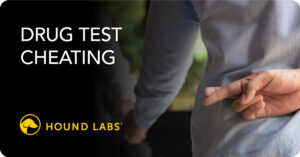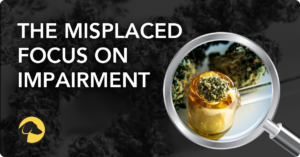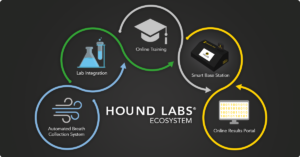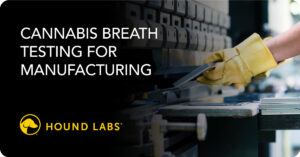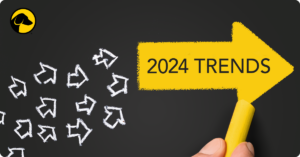
Top 5 Questions About the HOUND® CANNABIS BREATHALYZER
As I approach my 5-year work anniversary at Hound Labs and reflect on my years with the company, one of the most interesting parts of the job has always been hearing what questions people have about the HOUND® CANNABIS BREATHALYZER. I have been asked hundreds of questions over the years – ranging from how it works to when and how it will be used to why such a tool is needed in the first place – so I’ve started compiling a list of the top questions. This is the first in a series of blogs in which I will share answers to some of the most popular and interesting questions. If you have a topic that you would like me to cover in a future blog, please send an email to me at houndlabs@houndlabs.com.
Q: Who will use the HOUND® CANNABIS BREATHALYZER?
A: Interest in the HOUND® CANNABIS BREATHALYZER spans industries, company sizes, state lines, and more; almost any business that wants to maintain safety in a fair way can benefit from using the solution.
Think about an oil company where a mistake made by a cannabis-impaired worker could have disastrous health, safety, and environmental consequences. Next, think about a local tree-trimming service where a mistake made at the top of a cherry picker may not make the national news, but could cause loss of life or limb to an employee or member of the public. Finally, think about a construction company that cannot risk impairment during shifts but must balance the struggle to find qualified workers who can pass a pre-employment urine test for cannabis.
In all these examples, the employer wants and needs to continue drug testing to deter and detect cannabis use on the job because of the possible consequences of cannabis impairment at work. But these employers also recognize that testing for off-duty cannabis use limits the pool of candidates, isn’t fair to employees, and doesn’t make their workplaces safer because cannabis impairment lasts only hours (not days or weeks).1 The HOUND® CANNABIS BREATHALYZER will allow them to test for recent cannabis use (within the last few hours) so they can keep their workplaces safe while treating employees fairly.
Q: Will only companies in safety-sensitive industries use the HOUND® CANNABIS BREATHALYZER?
A: Not at all – there are lots of reasons other than overt safety risk that cause companies to seek a better cannabis test.
First, even without a safety-sensitive designation, many jobs expose employees and customers to hidden safety concerns. For example, while an administrative employee at a hospital may not treat patients, mistakes caused by the recent use of cannabis could result in issues that may impact patients’ care. Additionally, security of data and sensitive information, and protection of a brand’s reputation can contribute to an employer’s desire for a drug testing program. What if IT personnel used cannabis during work hours and caused system-wide outage? It may not be a safety issue but could well be a productivity and profit issue.
Q: How will employers use the HOUND® CANNABIS BREATHALYZER?
One of the more interesting trends has been employers’ interest in shifting from pre-employment to post-hire testing. These employers realize that non-negative results for cannabis on a pre-employment urine screen may no longer indicate illicit use or align with the cannabis window of impairment that last a few hours. They are beginning to understand the importance of a negative test and know they need a more relevant test so they do not subject employees to adverse action if they legally use cannabis outside of work hours.
Many of the employers who contact us are proactively evolving their programs to replace or augment pre-employment testing with post-hire cannabis breath testing, which identifies only very recently used cannabis. Implementing programs that incorporate pre-access, random, and reasonable suspicion breath testing can deter and detect recently used cannabis before an incident happens, and post-accident breath testing can be used to assess whether cannabis use may have contributed to the accident.
Drug testing continues to be critical to keeping workplaces safe and holding employees accountable, but post-hire testing using the HOUND® CANNABIS BREATHALYZER opens the door to more candidates and allows employees to use cannabis responsibly during their personal time if they wish.
Q: Are employees really using cannabis at the workplace?
A: According to a recent report by Quest Diagnostics, cannabis positivity increased 16.1% in urine tests and 35.2% in oral fluid tests between 2019 and 2020 in the general U.S. workforce.2 While neither of these numbers correlate directly with use on the job because of the extended windows of detection associated with those tests, the data does indicate an overall increase in cannabis use among workers. Coupling the Quest survey results with the results of a 2019 survey by a Pacific Northwest-based communications company that found that 1 in 4 cannabis users admitted to getting high at work,3 employers can reasonably anticipate increased positivity rates.
In addition to surveys, my colleagues and I hear stories regularly about employers who worry about their employees’ safety. Managers often see and hear things and know from conversations with employees that acceptance of legal cannabis use continues to increase. HR departments across the country are grappling with how to continue cannabis testing when they have so many open positions to fill.
Q: Have any employers used the HOUND® MARIJUANA BREATHALYZER?
A: We have used the HOUND® CANNABIS BREATHALYZER on location with employers who wanted their managers and shift employees in Oregon and California to provide feedback on their experience. These events were also important in helping us identify training protocols that will be easiest and most effective as we educate employers about how to use the Hound® solution.
Stay tuned for future installments of “What You Want to Know.” We’ll cover FAQ related to how the product works and the science that supports the HOUND® CANNABIS BREATHALYZER.

October 7, 2021
By LOUISA ASHFORD
Director of Marketing
Share
